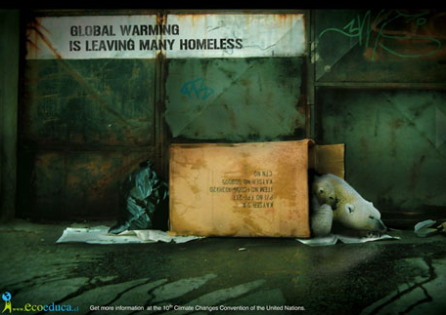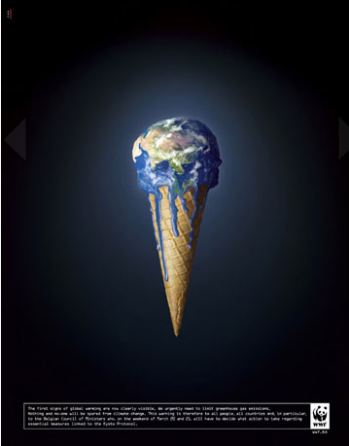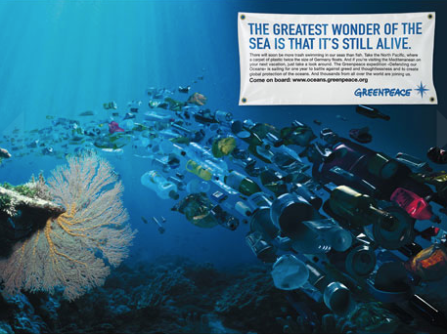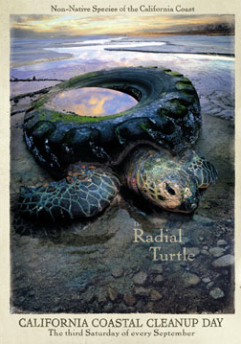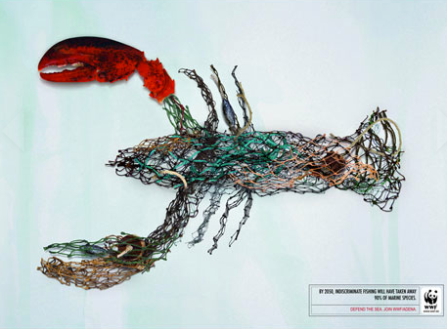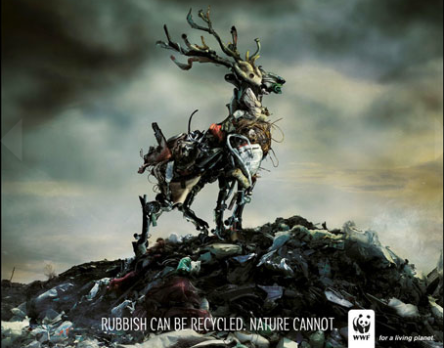In environmental advertising, the visual and conceptual aspect of a specific advertisement has a great effect on whether the viewer wants to join a campaign or simply look past it. These advertisements range from the dangers of global warming, littering, not recycling, and how it affects the environment and the animals that live within it. Most of the time, environmental advertisements are simple, dull, and ignored. The most important thing about environmental advertisements is that they must be visually stimulating and captivating to create emotion within the viewer.
Advertising Environmental Problems
Society creates many of our current problems within the environment. When there are people who do not care about the world they live in, complications start to arise. As these problems arise, land and life is in danger. Environmentalists are left with the job and dedication to get the world to care about the way they live and who and what they affect. Most of society either does not know or does not care about the ways they harm the environment and the animals that are in danger. This is where advertising comes in. This can be in the form of TV commercials, radio commercials, and photographic advertisements. Each of these grasps the viewers in different ways. Therefore, it is important to make an advertisement strong and effective.
When an environmental advertisement is placed on TV, in a magazine, on the radio, or somewhere on the Internet, more often than not, it is overlooked and ignored. This is because they are not visually stimulating or captivating, therefore never evoking a reaction in the viewer. A reaction is what gets the viewer to follow through and do something because they are affected by the advertisement. When the viewer has an emotional response from something visually captivating, they are more inclined to do something about it: whether it be donating money or changing the way they live their life.
The Importance of Creative Visuals
In environmental advertising, the creator of the advertisement must produce a message not only through text, but most importantly through image. When this fails, it is hard to get awareness out about what is harming our environment.
The artistic and visual aspect of environmental advertising creates either an effective or ineffective response from society. When done right, and environmental advertisement will cause the viewer to act towards the movement to protect the environment. When done wrong, the advertisement is just ignored. These next few environmental advertisements prove to be effective as they are visually motivating and encouraging to save our planet. The messages explored in these ads are supported by visual evidence.
Global Warming Is Leaving Many Homeless
In an advertisement released by Ecoeduca, seen below, the dangers of global warming are represented. Global warming affects wildlife immensely. With a warming climate, crucial habitat foundations are put into jeopardy (“Effects on Wildlife and Habitat”). This means hunting grounds for polar bears are slowly disappearing. Rising ocean temperatures will lead to a decline in fish population and rising sea levels will result in leaving wildlife without places to breed and raise or feed offspring (“Effects on Wildlife and Habitat”). This ultimately leads to a decline in any wildlife population.
In Ecoeduca’s advertisement, the message portrayed is that “Global Warming is Leaving Many Homeless”. In the photo are two polar bears, a mother and her cub, living in a cardboard box out of newly assigned home. When analyzing this photo, the viewer can see the harsh surroundings these polar bears are placed in. Symbolically, this image shows what will happen if society does not change their ways to reduce the possibilities of global warming. Right away, the image captures the viewer’s attention. It is visually compelling because it is very creative and stirs up emotion.
When the viewer sees that there animals living in a cardboard box and not in the arctic where they belong, they begin to feel sympathy. As emotions are felt, the viewer is more inclined to read further into the image and what it means. Aside from the textual message along the top of the photo, there is water running along the ground, symbolizing the warming climate that is leaving these polar bears homeless. The goal of this advertisement is to lead people to change their ways of living to prevent global warming from killing these wild creatures.
(http://www.thedailygreen.com/environmental-news/latest/environmental-ads-44102408#slide-11)
The First Signs of Global Warming are Now Clearly Visible
The next advertisement, released by WWF (World Wildlife Fund), about global warming also grabs the viewer’s attention. This image shows the world appearing as melting ice cream on top of a cone. Children identify closer to this advertisement than the previous one because it is more understandable for them. If they can identify with something they enjoy, like ice cream, they can easily connect with it and begin to pick apart the message portrayed. When anyone views this, they can see the world melting and then wonder why. Viewers have a visual understanding of what is happening in their environment when they look at WWF’s advertisement. Global warming leads to a “loss of sea ice, accelerated sea level rise and longer, more intense heat waves” (“Current Consequences”). We can see in the photo that the melted ice cream symbolizes the “melting” earth. Much of this comes from the greenhouse effect. This means that gases in the atmosphere trap infrared radiation, making the planet warmer.
This advertisement is visually captivating because it is something that most of society can identify with. Because ice cream is known to melt easily, WWF created this advertisement to show how easily the Earth can “melt” if society does not begin to change the way they live their life. With a message stating “The first signs of global warming are now clearly visible. We urgently need to limit greenhouse gas emissions”, the image begins to make even more sense. The viewer is then able to grasp the entire message being portrayed. The melting earth atop the ice cream cone allows viewers of young ages to grasp onto the concept, therefore spreading the message throughout a wider audience.
(http://www.thedailygreen.com/environmental-news/latest/environmental-ads-44102408#slide-2)
The Greatest Wonder of the Sea is that it’s Still Alive
Aside from global warming, both wildlife and the environment are deeply affected by trash. Trash is seen on the ground, in the ocean, lakes, rivers, everywhere, every single day. Society becomes lazy and irresponsible when it comes to disposing trash properly. In an article written by Jeffrey Lin, he states, “we still practice dangerous and unsafe ways of taking care of trash” (Lin). This leads to the destruction of habitats both on land and in the ocean.
In an advertisement released by Greenpeace, picture below, a school of fish is transformed into a school of plastic and glass bottles swimming through the ocean. Out of all the trash floating on the ocean’s surface, 90% of it is plastic (“Plastic Pollution”). This is a huge problem because plastic does not biodegrade. Instead of having a chance to slowly vanish from the ocean, “it photo-degrades with sunlight, breaking down into smaller and smaller pieces, but they never really disappear” (“Plastic Pollution”). When this happens, these tiny plastic pieces are “eaten by marine life, wash up on beaches, or break down into microscopic plastic dust, attracting more debris” (“Plastic Pollution”). This ultimately leads to a decline in marine population.
The symbolic aspect of this advertisement shows that there is so much trash in the ocean that it is replacing marine life. Marine life becomes replaced because these animals continue to die. The message on the advertisement reads, “The Greatest Wonder of the Sea is That It’s Still Alive”. The sea contains so much debris and trash that it becomes hard to believe that animals are still living in this disastrous and deadly environment. Because of this, “over 100,000 marine mammals and one million seabirds die each year from ingesting or becoming entangled in plastic” (“Plastic Pollution”). Greenpeace has created this advertisement to capture the viewer’s attention. By seeing all of these bottles embodying a school of fish, it helps the viewer realize how big of a problem this really is.
Marine life will continue to ingest these toxic plastics for as long as it remains in the ocean. One article supports this, stating, “when animals – fish or other marine organisms – ingest those plastics, there’s some accumulation of those toxins in their systems and as they move up the food chain”(Bolstad). This will lead to even more marine life dying along the food chain. The viewer can relate the textual message with the visual message, ultimately affecting the viewer even greater. From this advertisement, one can hope that society begins to take responsibility and action to properly dispose of plastic bottles and other waste.
(http://www.thedailygreen.com/environmental-news/latest/environmental-ads-44102408#slide-5)
Non-Native Species
Along with plastic bottles and other types of trash overpopulating the ocean, much of it washes up on shore affecting the land on the beach. Various items of trash include mattresses, sports balls, and tires, just to name some of the not-so-common trash. No matter what kind of trash, it still affects the environment and wildlife. One article states, “Every piece of trash affects the health of the ocean and as a result the economy, the environment and animal health” (Boldstad).
The advertisement below, released for California Coastal CleanUp Day, expresses the dangers of trash in our environment. The tire makes up the body of the tortoise, symbolizing that it is clearly a non-natural species. The message states, “Non-Native Species of the California Coast”, supporting the representation that trash is overpowering wildlife in several different environments. When looking at this advertisement, the first thing that is noticed is that there appears to be a sea turtle. Looked at even closer, the viewer begins to notice the tire and then the message that is being portrayed. These animals of trash are not native to our planet. Society has created them out of a lack of responsibility to properly dispose trash.
In response to the problem of trash washing up on beaches, there have been many “Coastal Clean-up” events that help clean the trash from these environments. This creates healthier habitats for many different species of animals. In 2012, “more than 550,000 people picked up in excess of 10 million pounds of trash along 17,719 miles of international coastlines in September” to help maintain a healthier and more sustainable environment for humans and animals (Boldstad). It is not enough to just clean up the trash and move on. This is an everyday occurrence along hundreds of thousands of miles of coastlines. To possibly prevent this from happening in such excessive amounts, “the Ocean Conservancy would like people to focus next on producing less waste before it even makes its way into the oceans” (Boldstad). This would slowly decrease the deaths among marine wildlife, leading to a happier and healthier environment.
(http://www.thedailygreen.com/environmental-news/latest/environmental-ads-44102408#slide-9)
Indiscriminate Fishing
Another environmental advertisement explores the dangers of indiscriminate fishing. This means that many species of fish are slowly decreasing because of the unethical fishing methods that are trending. In one article expressing the dangers of indiscriminate fishing, Monica Verbeek explains that a major problem that deeply affects marine life is the practice of deep sea fishing where fishing gear is dragged along the bottom of the ocean for hours before being brought to the surface. She writes, “This fishing method is indiscriminate and regularly results in the bycatch of several threatened deep-sea sharks and other non-commercial species, which are thrown back dead,” (Verbeek). This just shows how unethical these fishermen are. They are more concerned about money than the well being of animals in their natural environment.
In the advertisement below, created by WWF, a message stating, “By 2050, indiscriminate fishing will have taken away 90% of marine species.” This is a huge number that should not be easily overlooked. The lobster in this image is made out of 90% of fishing line and net while only 10% of it is an actual lobster. This symbolizes the 90% of marine species that will have been killed by indiscriminate fishing. Large-scale fishing on the bottom of the sea is causing the most destruction among marine populations.
Although the text is small, the image speaks for itself. However, the viewer may not fully understand the symbolic meaning of the lobster without reading the small print message. But, because the message is in small print, the viewer may be more inclined to read what the image represents. This leads the viewer to look further into the meaning and the dangers that indiscriminate fishing lead to. If we do not act on these concerns now, it may be too late to save much of marine life.
(http://www.thedailygreen.com/environmental-news/latest/environmental-ads-44102408#slide-6)
Rubbish Can Be Recycled, Nature Cannot
This next advertisement, also released by WWF, portrays the problems that trash has on the environment and animals. The message seen in this advertisement states that “Rubbish can be recycled. Nature cannot.” One huge problem within society is that many of us do not know or care to recycle our trash. Instead, we throw it on the ground or do not support recycling. This leads to many deaths of numerous types of animals, large and small. Animals may choke on small trash thrown on the side of the road, or may be attracted attract animals to this trash on the road, which often leads to roadkill. Another problem with our trash in the world is improper disposal.
When animals come in contact with any type of human trash, they are easily at risk for harm. This harm includes toxins, jars that the animals may become stuck in, foods they may choke on, and strings or fishing lines that they may become tangled in. Society does not necessarily take these problems into consideration. If a probable and responsible way of disposing trash can be adopted by everyone, we can significantly decrease the number of deaths among wildlife.
This advertisement by WWF shows a deer created out of trash. The symbol of this image is that there is so much trash in our world that it is consuming animals and their habitats. These animals are becoming the trash because they have no other choice. This image attracts the viewer to take a closer look because it is visually attractive and evokes emotion. When emotion is felt, it creates a stronger impact. This can influence the viewer to live a different lifestyle and truly think about how they dispose of their trash. With effective environmental advertisements like this, it is easier to grasp onto the dangers of these environmental problems. It helps to have a visual to look at and connect to with curiosity and interest. If the viewer is engaged with what they are looking at, it will cause them to do something about it.
(http://www.thedailygreen.com/environmental-news/latest/environmental-ads-44102408#slide-4)
The Success of Visual Awareness
The way that many environmental advertisements go about expressing an environmental problem and concern often go by unnoticed. In order to grab the viewer’s attention and get them to join a cause, the advertisement must be visually stimulating. These six advertisements portray a successful attempt at spreading environmental awareness. Each and every one of them has artistic and creative elements that are visually appealing to the viewer and evoke some type of emotion when looked at. After analyzing these six environmental advertisements, it is clear that they are thought provoking. The images symbolize the messages being depicted, leaving the viewer with a greater impact. Without these images, the textual messages would never be effective.
Works Cited
- Bolstad, Erika. “Beach Litter Mars U.S. – and World’s – Coastlines.” Star-Telegram.com. Star-Telegram, 13 May 2013. Web. 14 May 2013.
- “The Current and Future Consequences of Global Change.” NASA. Earth Science Communications Team, n.d. Web. 14 May 2013.
- “Effects on Wildlife and Habitat.” National Wildlife Federation. National Wildlife Federation, n.d. Web. 14 May 2013.
- “Getting The Message Across – Environmental Ads.” Blog.SpoonGraphics. Chris Spooner, n.d. Web. 08 May 2013.
- Lin, Jeffrey. “The Effects of Garbage on Our Environment.” Ezine Articles. SparkNET, n.d. Web. 14 May 2013.
- “Plastic Pollution.” TakePart. Take Part, LLC, n.d. Web. 14 May 2013.
- Ries, Al. “Creative Strategy Importance: Visual Or Verbal?” Branding Strategy Insider. The Blake Project, 18 Sept. 2009. Web. 08 May 2013.
- Rothenberg, Randall. “THE MEDIA BUSINESS: Advertising; Translating Environment Into Ads.” The New York Times. The New York Times, 04 Nov. 1988. Web. 08 May 2013.
- Verbeek, Monica. “Deep-sea Species at Risk from Indiscriminate Fishing.” Public Service Europe. Public Service Europe, 22 Sept. 2011. Web. 14 May 2013.
